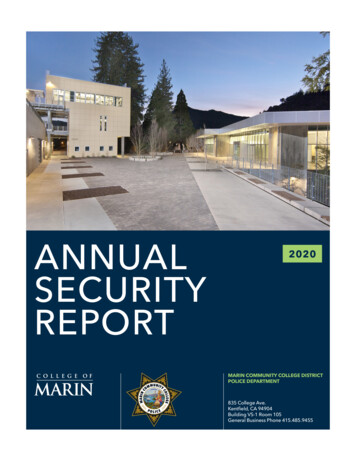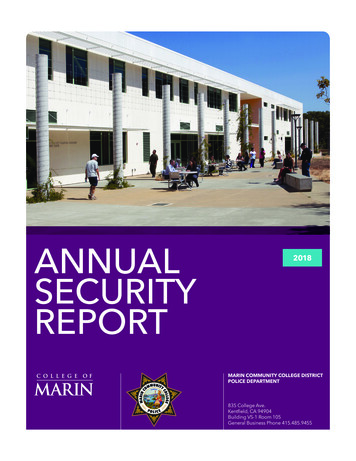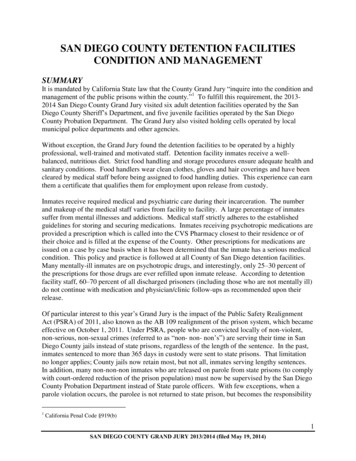
Transcription
U.S. Department of the InteriorU.S. Geological SurveyNaturalGemstones
i* H
U.S. Department of the InteriorU.S. Geological SurveyNaturalGemstonesSearching for gemstones in the United Statesis a popular recreational activityfor collectors and hobbyistsCover: Quartz, Rhode Island.Inside covers: Amethyst crystals, Mexico.
Natural gemstonesA natural gemstone is a mineral, stone, ororganic matter that can be cut and polishedor otherwise treated for use as jewelry orother ornament. A precious gemstone hasbeauty, durability, and rarity, whereas asemiprecious gemstone has only one or twoof these qualities. A gem is a gemstone thathas been cut and polished.Diamond, corundum (ruby and sapphire),beryl (emerald and aquamarine), topaz, andopal are generally classed as preciousstones. All other gemstones are usuallyclassed as semiprecious.A mineral is any naturally formed homogeneous inorganic material.A mineralogist is a person who studies theformation, occurrence, properties, composition, and classification of minerals.A gemologist is a person who has successfully completed recognized courses ingemology (the science and study of gemstones) and has proven skills in identifyingand evaluating gem materials.A lapidary is a cutter, polisher, or engraverof precious stones.Geologic environmentGemstones are not plentiful. Gemstones donot form "ore" deposits in the normal sense.Gems, when present at all, tend to be scattered sparsely throughout a large body ofrock or to have crystallized as small aggregates or fill veins and small cavities.Even stream gravel concentrations tend tobe small a few stones in each of severalbedrock cracks, potholes, or gravel lensesin a stream bed.The average grade of the richest diamondkimberlite pipes in Africa is about 1 partdiamond in 40 million parts "ore."Kimberlite, a plutonic igneous rock, ascends from a depth of at least 100 kilometers (60 miles) to form a diatreme (narrowcone-shaped rock body or "pipe"). Moreover, because much diamond is not of gemquality, the average stone in an engagementring is the product of the removal and processing of 200 to 400 million times itsvolume of rock.Gemstones occur in most majorgeologic environments.Each environment tends to have a characteristic suite of gem materials, but manykinds of gems occur in more than one environment. Most gemstones are found inigneous rocks and alluvial gravels, butsedimentary and metamorphic rocks mayalso contain gem materials.Examples of geologic environments inwhich gemstones are found:Pegmatite a coarse-grained intrusiveigneous rock body, occurring as dikes (atabular-shaped body), lenses, or veins in thesurrounding rock.Stream gravels (placers) deposits ofheavier and more durable than averageminerals that have been eroded out of theoriginal rock. Often tourmaline, beryl, andmany other gem-quality minerals haveeroded out of the original rock in whichthey formed and have moved and beenconcentrated locally by water in streams.Sapphires in Judith Basin County, Montana, were first found when the gravelswere worked for gold from 1895 to 1930.Metamorphic rocks rocks that have beenaltered by great heat, pressure, or both.Garnet, for example, is commonly found ascrystals in gneiss and mica schist.
Quartz with phantoms, Brazil.
Aquamarine, Brazil.
Mineral gemstonesHardness and specific gravity are two of themajor characteristics of gemstones.Hardness of a gemstone is its resistance toscratching and may be described relative toa standard scale of 10 minerals known asthe Mohs scale. F. Mohs, an Austrian mineralogist, developed this scale in 1822.According to Mohs'Talc is 1Gypsum is 2Calcite is 3Fluorite is 4Apatite is 5scale, the hardness ofFeldspar is 6Quartz is 7Topaz is 8Sapphire is 9Diamond is 10Specific gravity is the number of timesheavier a gemstone of any volume is thanan equal volume of water; in other words, itis the ratio of the density of the gemstone tothe density of water.The 16 mineral gemstone groups listedbelow are highly prized for their beauty,durability, and rarity:Beryl (hardness: 7.5-8 Mohs)Beryllium aluminum silicateSpecific gravity: 2.63-2.91Emerald: Intense green or bluish greenAquamarine: Greenish blue or light blueMorganite: Pink, purple pink, or peachHeliodore: Golden yellow to golden greenRed beryl: Raspberry redGoshenite: Colorless, greenish yellow,yellow green, brownishChrysoberyl (hardness: 8.5 Mohs)Beryllium aluminum oxideSpecific gravity: 3.68-3.78Chrysoberyl: transparent yellowish green togreenish yellow and pale brownAlexandrite: red in incandescent light andgreen in daylightCat's eye: usually yellowish or greenishCorundum (hardness: 9 Mohs)Aluminum oxideSpecific gravity: 3.96-4.05Ruby: Intense redSapphire: BlueDiamond (hardness: 10 Mohs)CarbonSpecific gravity: 3.51Colorless to faint yellowish tinge, alsovariableFeldspar (hardness: 6-6.5 Mohs)Two distinctly different alkali aluminosilicates: the Plagioclase and the AlkaliFeldspar SeriesSpecific gravity: 2.55-2.76Plagioclase SeriesLabradorite: Colorful, iridescent, alsotransparent stones in yellow, orange, red,and greenSunstone: Gold spangles from inclusionsof hematitePeristerite: Blue white iridescenceAlkali Feldspar GroupOrthoclase: Pale yellow, flesh redAmazonite: Yellow green to greenish blueMoonstone: Colorless; also white toyellowish, and reddish to bluish grayGarnet (hardness: 6.5-7.5 Mohs)A group of silicate mineralsSpecific gravity: 3.5-4.3Almandine: Orangy red to purplish redAlmandine-spessartine: Reddish orangeAndradite: Yellowish green to orangyyellow to blackDemantoid: Green to yellow greenandraditeTopazolite: Yellow to orangy yellowGrossular: Colorless; also orange, pink,yellow, and brownTsavorite: Green to yellowish greenHessonite: Yellow orange to redPyrope: Colorless; also pink to redChrome pyrope: Orange red
Pyrope-Almadine: Reddish orange to redpurplePyrope-Spessartine: Greenish yellow topurpleMalaia: Yellowish to reddish orangeto brownColor-change garnet. Blue green in daylight to purple red in incandescent lightRhodolite: Purplish red to red purpleSpessartine: Yellowish orangeUvarovite: Emerald greenJade (hardness: 6 Mohs)NephriteCalcium magnesium silicateSpecific gravity: 2.9-3.1White, deep green, creamy brownlazurite with variable amounts of pyrite(brassy flecks) and white calciteSpecific gravity: 2.7-2.9Deep blue, azure blue, greenish blue (bluishcolor with flecks of white and gold)Opal (hardness: 5.5-6.5 Mohs)Hydrated silicaSpecific gravity: 1.98-2.25White opal: Opaque, porcelain-like whitematerial; colors resemble flashes orspecklesBlack opal: Flashes and speckles appearagainst black backgroundWater opal: A transparent, colorless opalis the background for brilliant flashes ofcolorFire opal: Reddish or orange opalJadeiteSodium aluminum silicateSpecific gravity: 3.1-3.5White, leafy and blue green, emerald green,lavender, dark blue green and greenishblack, deep emerald-greenLapis lazuli (hardness: 5-5.5 Mohs)A rock composed mainly of the mineralPeridot [Olivine] (hardness: 7 Mohs)Magnesium iron silicateSpecific gravity: 3.22-3.45Olive to lime greenQuartz (hardness: 7 Mohs)Silicon dioxide or silicaSpecific gravity: 2.65Coarsely crystalline varieties of silicaRock crystal: ColorlessAmethyst: PurpleCitrine: Yellow to amberMorion: BlackSmoky quartz or cairngorm: smoky grayto brownRose quartz: Translucent pinkGreen quartz or praziolite: GreenCryptocrystalline varieties of silicaChalcedony and Jasper (variable)Agate: Bull's eye agate, Iris or fire agate,Onyx, Sardonyx. Bloodstone or heliotrope.Cornelian. Chrysoprase. Moss agate.Plasma. Prase. Sard. Jasper.Diamond Star of Sierra Leone.Spinel (hardness: 8 Mohs)Magnesium aluminum oxideSpecific gravity: 3.58-4.06
Candelabra: white quartz, blue-capped red elbaite, and tan albite, California.Balas ruby: RedAlmandine spinel: Purple redRubicelle: OrangeSapphire spinel and ghanospinel: BlueChlorspinel: GreenTopaz (hardness: 8 Mohs)Aluminum silicate fluoride hydroxideSpecific gravity: 3.5-3.6Indicolite: Dark blueRubellite: Pink to redSiberite: VioletVerdilite: GreenTurquoise (hardness: 5-6 Mohs)Hydrous copper aluminum phosphateSpecific gravity: 2.6-2.8Sky blue; greenish blueWine yellow, pale blue, green, violet, or redTourmaline (hardness: 7-7.5 Mohs)Complex aluminum borosilicate(Elbaite, Dravite, Uvite)Specific gravity: 3.03-3.25Zircon (hardness: 7.5 Mohs)Zirconium silicateSpecific gravity: 4.6-4.7Jargon: VariableMatura diamond: ColorlessAchorite: ColorlessBrazilian emerald: GreenDravite: BrownHyacinth: Yellow, orange, red, brown
The Hooker Emerald, Colombia.BirthstonesMonthof GarnetAmethyst (Quartz)Aquamarine (Beryl)or Bloodstone(Quartz)Diamond orRock Crystal(Quartz)Emerald (Beryl)or Chrysoprase(Quartz)Pearl or Moonstone(Feldspar)Dark redPurplePale blueColorlessBright greenPale greenMonthof erGemstoneColorRuby (Corundum)or Carnelian(Quartz)Peridotor Sardonyx(Quartz)Sapphire(Corundum)or Lapis LazuliOpal or TourmalineTopaz or Citrine(Quartz)TurquoiseRedPale greenBrownand whitePale to darkblueDeep blueVariegatedYellowSky blue
Organic gemstonesThe four organic gemstone groups listedbelow are highly prized for their beauty andrarity. However, they are not as durable asgemstones from minerals:Amber (hardness: 2-2.5 Mohs)A mixture of hydrocarbonsSpecific gravity: 1.05-1.096Hard fossil resin or sap of ancient pinetrees. Usually amorphous (lacks crystallinestructure). Sometimes mined, sometimesgathered on seashores.Varies from transparent to semitransparentand generally from light yellow to darkbrown, but can be orange, red, whitish,greenish-brown, blue, or violet. Can bedyed in any color.Takes a fine polish. Used mainly in makingbeads or other ornaments.Coral (hardness: 3.5-4 Mohs)Formed mainly of calcite (calcium carbonate) or conchiolin, a horny organic substanceSpecific gravity: 2.60-2.70Each coral polyp, a tiny marine animal thatlives in enormous colonies, extracts calcium carbonate from the sea and exudes itto build a protective home around andabove itself. Each generation of polyps diesin its protective home and each succeedinggeneration builds on top of its predecessor.Gem coral ranges from semitranslucent toopaque and occurs in white, pink, orange,red, blue, violet, golden, and black. Theblack and golden corals are largely hornyorganic substances, not calcium carbonate.The finest coral is used to make figurines,cameos, carvings, and beads.Jet (hardness: 2.5-4 Mohs)Carbon plus various hydrocarboncompoundsSpecific gravity: 1.30-1.32This compact velvet-black coal takes agood polish and is often cut into beads,bracelets, and a wide range of decorativeand useful objects.Pearl (hardness: 2.5-4.5 Mohs)Formed within a mollusk, such as an oyster,that deposits a substance called nacrearound an irritant that entered the organismSpecific gravity: 2.71Pearl-bearing mollusks are found in bothsalt and fresh water. Salt-water pearls ofgem quality are usually preferred for jewelry; they are produced almost entirely bythe mollusk Pinctada. Fresh-water pearlsare produced by various clams and mussels.Natural pearls come in various shapes:round, pear, drop, egg, and others. Theyalso come in various colors, such as white,cream, light rose, cream rose, black, gray,bronze, blue, dark blue, blue green, red,purple, yellow, and violet.Buyer bewareInexperienced buyers must take whateversteps are needed to ensure that gems theyintend to purchase are exactly what theseller purports them to be and that they arebeing offered at a fair market price.More and more synthetic gems and inferior grades and cuts of natural gems arebeing sold to unwary buyers by unscrupulous sellers.
Since 1935, the mining of gemstonesin the United States has been almostentirely a recreational activityof mineral collectors and hobbyists.In recent years, very few individuals havederived their entire income from gemstonesmined by themselves.This is not to say that the proprietors ofroadside rock shops buy all of their stockfrom others. Rock shops are abundant inareas of the United States that are rich ingem materials, and the shops tend to specialize in the local gem commodities, mostof which the proprietors gather.Rather than doing the mining themselves,owners of land that has a deposit of gemquality minerals sometimes charge hobbyists for the right to collect gemstones. Forexample, diamond in Arkansas, opal inIdaho, and agate in Oregon and Washingtonare mined by hobbyists under this "feedigging" arrangement.However, the flow of money into the localeconomy by paying these small fees and bythe purchase of gemstones is minor compared to the money the enthusiasts spendfor lodging and other living expenses whilevisiting an area to dig for gemstones.Several kinds of natural gemstones havebeen found in every State of the UnitedStates, but much larger deposits of the mostprecious kinds are found outside the UnitedStates.The 1990 U.S. output of natural gemstones was primarily from Tennessee, California, Arizona, Arkansas,Montana, Nevada, and Maine.An estimated 80,000 visitors found a totalof 315 carats of diamonds in the Crater ofDiamonds State Park in Arkansas. Therewere sizeable yields of freshwater pearls inTennessee, turquoise in Arizona and Nevada, tourmaline in Maine, and tourmaline,kunzite, and garnet in California.10Gemstones: Value of U.S. productionvs. imports, 1986 and 1989*Production1986NaturalSynthetic 9.3 million 43.0 million**10.323.5 19.6 66.5Mineemployment300Imports forconsumption: 4.18 billionApparent relianceon importsover exports***99%1989800 5.00 billion98%'Estimated. "Including freshwater pearls natural,and cultured. '"Imports - exports adjustmentsfor Government and industry stock changes.Source: Mineral Commodity Summaries, 1991,U.S. Bureau of Mines.U.S. production of commercial gems includes agate, beryl, freshwater pearl, garnet,jade, jasper, mother-of-pearl, opal, peridot,quartz, sapphire, tourmaline, and turquoise.Except for the few gem diamondsfound each year in Arkansas, U.S.diamond production is very low.Yet exploration for diamonds continues inAlaska, Colorado, Michigan, Minnesota,Wisconsin, and Wyoming. A diamondmining project at the Crater of DiamondsState Park in Arkansas is still being evaluated by the State.World diamond reserves are estimated to be about 300 million carats,including near-gem materials but notdiamonds of abrasive quality.Most of the reserves are in southern Africa,Siberia, and western Australia. It is difficult to estimate reserves because the valueof a given deposit varies with the market forthe gems.
Jade nephrite, China.11
The Hope Diamond, India.Chemical formulas of parGarnet12Be3AI2Si6O 18BeAI 2O4CaCO3AI203CPlagioclase Series:(Na,Ca)AI(AI,Si)Si 2O8Alkali Feldspar Group:Mixtures of OrthoclaseKAISi 3O8 and AlbiteNaAISi3O8Almadine Fe3AI2(SiO4) 3Andradite Ca3 Fe2 (SiO4) 3Grossular Ca3AI2 (SiO4) 3Pyrope Mg 3AI2 (SiO4) 3Spessartine Mn 3AI 2 (SiO4) 3Uvarovite Ca3Cr2(SiO4) 3Nephrite-Ca2(Mg,Fe) 5(Si 8022) (OH) 2Jadeite NaAI(Si 2O6)Lapis lazuli Lazurite (Na,Ca)8(AISiO4)6(SO4,S,CI)2OpalHydrated SilicaSiO2 -nH 2OPeridot(Mg,Fe) ourmaline XY3AI 6 (B03) 3 (Si 60 18) (OH 4)[X is usually Na but maybe replaced by Ca; Y isone of several metal ions]Turquoise CuAI6 (P04) 4(OH) 8 -4H 20ZirconZrSiO4Jade
Some ways to contact a local rock,mineral, or gem clubIf you have access to the most recent AprilBuyer's Guide issue of the Lapidary Journal magazine, scan its lists of gem andmineral clubs in the United States and othercountries. (The address of the LapidaryJournal is given in the list of journals citedbelow.)Talk to a member of the geology or earthscience department of your local college oruniversity.Talk to a member of the science departmentof your local high school.Write to theEastern Federation of Mineralogicaland Lapidary Societies, Box 10119,Alexandria, VA 22310-0119or theMidwest Federation of Mineralogicaland Geological Societies306 SomonaukPark Forest, IL 60466Check the phone book for your nearest rockand mineral shop and talk to the owners.Role of the U.S. Geological Survey(USGS)The USGS reports deposits that seem likelyto contain gemstones. It is not a function ofthe USGS to exploit such resources.USGS geologists perform continuing research on kimberlites, the initial source ofdiamonds. Not all kimberlites are diamondbearing, and some of the research is directedto learning what indications you look forduring exploration to distinguish fertilefrom barren kimberlite. USGS geologistsare compiling a U.S. map showing thelocations of known kimberlites.Selected general referencesA trip to your local library is the best firststep toward understanding gemstones andtoward planning a trip to gem and rockshops or to places where you may be ableto collect gemstones.A list of Selected references on rocks,minerals, and gemstones is compiled andupdated every two years by the USGSGeologic Inquiries Group, 907 NationalCenter, Reston, VA 22092; (703) 648-4383.The list has three sections: selected guidesfor rockhounds and hobbyists, generalreferences for all ages, elementary school toadult, and periodicals.The guides in Section I tell about equipment needed for collecting, etiquette ofcollecting, map reading, organizing a collection, collecting localities by States,mineral societies, mineral show dates andlocations, and rock, mineral, and fossildealers.The references below focus mainly onnatural gemstones and the gems made fromthem rather than on synthetic gemstones,rocks, or other nongem minerals.Minerals YearbookThe relatively few pages on gemstones inthe multivolume Minerals Yearbook provide data on sources, kinds, and volume ofdomestic production, domestic consumption, prices, and foreign trade. This U.S.Bureau of Mines yearbook is in the reference sections of many major libraries. Itcan be purchased from the Superintendentof Documents, U.S. Government PrintingOffice, Washington, DC 20402.13
BooksGemology, Cornelius S. Hurlbut Jr. andRobert C. Kammerling: John Wiley &Sons, New York, 1991, 2nd ed.Gemstones and Their Origins, Peter C.Keller: Van Nostrand Reinhold, 1990.Color Encyclopedia of Gemstones, JoelArem: Van Nostrand Reinhold, New York,1987, 2nd ed., 68 p.Gemstones for Everyman, B.W. Anderson:Van Nostrand Reinhold, 1976, 268 p.Gems and Precious Stones, Curzio Ciprianiand Alessandro Boreli; Valeric Palmer,translator: Kennie Lyman, U.S. editor:Simon and Schuster, New York, 1986,384 p.Gem and Crystal Treasures, Peter Bancroft:Mineralogical Record, Carson City, NV,1984, 488 p.Planet Earth Gemstones, Paul O'Neil andthe editors of Time-Life Books: Time-LifeBooks, Arlington, VA, 1983, 176 p.Gemstones of the World, Walter Schumann(translated by Evelyne Stern): Sterling,New York, 1984, 256 p.Gems & Crystals from the AmericanMuseum of Natural History: An illustratedguide to the history, lore, and properties ofthe gems and minerals of one of the world'sgreatest collections, Anna S. Sofiandes andGeorge E. Harlow: Simon & Schuster, NewYork, 1990, 208 p.The Gem Collection (Treasures in the Smithsonian Series No.l), P.E. Desautels: Smithsonian Institution, Washington, 1983,77 p.14Gemstones of North America, JohnSinkankas: D. Van Nostrand Company,Inc., Princeton, 1959, 675 p.Gems and Precious Stones of NorthAmerica A popular description of theiroccurrence, value, history, archeology, andof collections in which they exist, G.F.Kunz: Dover Publishing, New York, 1968(reprint of a classic work dated 1892), 367 p.Emerald and Other Beryls, John Sinkankas:Chilton Way, Radnor, PA, 1981, 665 p.Handbook of Gem Identification, R.T.Liddicoat Jr.: Gemological Institute ofAmerica, Santa Monica, CA, 1981 (llthed.), 450 p.Field Collecting Gemstones and Minerals,John Sinkankas: Geoscience Press,Prescott, AZ, 1988, 2nd ed., 397 p.Prospecting for Gemstones and Minerals[Formerly Gemstones and Minerals: Howand Where to Find Them], John Sinkankas:Van Nostrand Reinhold, New York, 1970,2nd ed., 397 p.Mineral & Gem Trails of Delaware,Virginia, Maryland, North Carolina,Ed and Bert Sloan: EDSCO, Box 79,Oneonta, NY 13820, 1978, 52 p.Gem Testing, B.W. Anderson: Butterworth,Woburn, MA, 1980, 9th ed., 384 p.Gemology, C.S. Hurlbut Jr. and G.S.Switzer: Wiley, New York, 1979, 596 p.Gems and Jewelry, Joel Arem: BantamBooks, New York, 1975, 159 p.Gem Cutting: A Lapidary's Manual, JohnSinkankas: Van Nostrand Reinhold, NewYork, 1962, 2nd ed., 297 p.
Lavender-hued rose quartz, Brazil.15
JournalsGems and Gemology (quarterly). Articleson gemstone localities, identification, andhistory. Includes annual index, lab notes,book reviews, and gemological abstracts.Published by the Gemological Institute ofAmerica, 1660 Stewart Street, SantaMonica, CA 90404.Lapidary Journal (monthly). Articles ongemstones, locality information, expeditions to find sources of gemstones,gemcraft, club news, show news, productnews, and book reviews. Published by theLapidary Journal, Devon Office Center,Suite 201, 60 Chestnut Avenue, Devon, PA19333-1312.Rocks & Minerals (bimonthly). Featuresarticles of interest to students of mineralogy, geology, and paleontology. Includesarticles about gemstone localities. Regularlylists announcements of hundreds of mineral,rock, and gem shows (local, State, national,Canadian, and European). Includes mediareviews, museum notes and announcements,and classified ads. Published by HeldrefPublications, 4000 Albermarle Street, NW.,Washington, DC 20016.Jewelers' Book Club Catalog (annual).Catalog of more than 550 jewelry-relatedpublications from more than 250 publishers. Includes video- and audio-cassettes andbook reviews. Jewelers' Book Club News(quarterly) informs members of new titlesand provides book reviews. Published bythe Jewelers Book Club, Chilton Way,Radnor, PA 19089.VideocassettesGemstones of America (60 minutes),Smithsonian Institution, 1991, can beordered for 29.95 from the Museum Shop,Attention: Mail Order Clerk, NationalMuseum of Natural History, 10th Street andConstitution Avenue, NW., Washington,DC 20560; (202) 357-1535.16Splendid Stones. This National GeographicSociety special details the evolution fromraw material to cut and polished gem, outlines many of the steps involved in marketing gemstones, and examines some of theworld's most famous jewelry collections. Itcan be ordered for 95 from the NationalGeographic Society, 17th and M StreetsNW., Washington, DC 20036.AcknowledgmentsThe U.S. Geological Survey is gratefulto the following individuals for theirassistance:Harvey E. Belkin, Geologist, GeologicalSurvey, U.S. Department of the Interior,Reston, VA.Gordon T. Austin, "Gem Stones," MineralCommodity Summaries 1991, Bureau ofMines, U.S. Department of the Interior,Washington, DC.Robert E. Thaden, "Gem Stones," in UnitedStates Mineral Resources, GeologicalSurvey Professional Paper 820, U.S.Government Printing Office, Washington,1973, p. 247-250.Jane Jenness, Minerals Information Office,U.S. Geological Survey, Washington, DC.PhotographsAll photographs are courtesyof The Smithsonian Institution.
tat
stones) and has proven skills in identifying and evaluating gem materials. A lapidary is a cutter, polisher, or engraver of precious stones. Geologic environment Gemstones are not plentiful. Gemstones do not form "ore" deposits in the normal sense. Gems, when present at all, t











